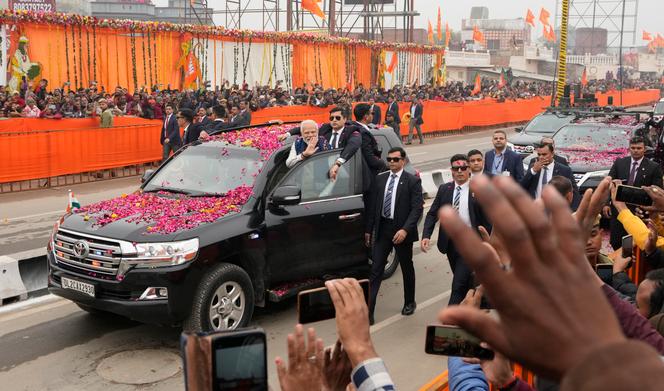


The flight, one of the first on the new direct route from Delhi to Ayodhya, quickly set the tone for what would later unfold on the tarmac. "Jai Shri Ram" ("glory to Lord Rama") and other chants punctuated much of the flight carrying the first Hindus to the holy city in northern India's Uttar Pradesh.
Upon arrival, groups of men draped in saffron and waving flags in the Hindu colors waited in a brand-new airport. Just a few days earlier, Indian Prime Minister Narendra Modi had inaugurated the new facility, which features a huge mural recounting the life of the god Rama, who is the seventh avatar of Vishnu. Never before has the Indian state invested so much money – the equivalent of over €3 billion – in a city of barely 55,000 inhabitants.
Ayodhya is being transformed with four-lane roads, bridges, parking lots and renovated buildings. According to Yogi Adityanath, the head of the Uttar Pradesh government and a fanatical monk, this city is set to be a model of "the new India" - a vision of a devout nation where politics and religion become one.
Entirely dedicated to Rama, the "Prince of Ayodhya," the city displays images of him and of the monkey god Hanuman (the other hero of the Ramayana epic) everywhere, even on bus shelters. Store owners, both Hindu and Muslim, have no choice: their storefronts, repainted by the government, now bear the words "Jai shri Ram" as well as Hindu symbols, including the swastika.
To get to Ayodhya, a majestic 13-kilometer road nicknamed the "Rampath" was constructed, which required the destruction of thousands of houses, stores, temples and mosques. On Monday, January 22, Modi will use this road to inaugurate the Ram Mandir, a temple dedicated to Rama, in a ceremony that will be exceptional in many ways.
The prime minister will be at the center of the event. He has sidelined all the historical players in the battle over this temple, personalizing the inauguration to the extreme, to the point of arousing the ire of the clerics – who denounce its political use – and a boycott from the opposition. At the laying of the foundation stone on August 5, 2020, Modi compared the event to Independence Day.
The whole country was invited. Temporary tent cities have been set up on the nearby banks of the Sarayu River, a tributary of the Ganges, to accommodate thousands of worshippers. Dozens of private jets will transport India's elite, including industrialists, Bollywood stars and politicians. Seven thousand five hundred people are expected to attend. Giant screens set up throughout the country and in major Indian embassies around the world will broadcast live the moment when Modi, surrounded by Hindu priests, installs a statue of Rama in the sanctuary.
You have 65% of this article left to read. The rest is for subscribers only.
